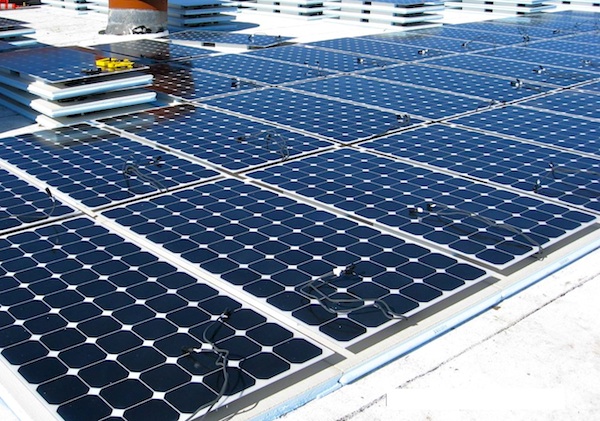The huge 500-kilowatt solar installation at the Bay Area Beverages building, which you can see while driving west on 580 just before the Canal Boulevard exit, is quickly becoming a landmark. This solar installation, along with 52 others in Richmond, was one of the reasons that the Northern California Solar Energy Association recently gave the city an award for installing more solar watts per capita than any other large city in California.
“I think the category that Richmond won is one of the best metrics to win,” said Adam Lenz, sustainability coordinator for the city of Richmond. “It just shows in an even playing field amongst cities, regardless of size, who is pulling their weight the most by installing renewable energy.”

Based on the 2009 Bay Area Solar Installations Report, the Northern California Solar Energy Association, on July 14th awarded prizes to Richmond and other Bay Area cities for their adoption of solar energy. Richmond won two awards in the large city category: first place in watts per capita installed and second place in total watts installed.
The report shows that the Bay Area leads California in new solar installations. Since 2007, with the launch of the California Solar Initiative, a state incentive program, the total number of systems and total megawatts installed have almost doubled and tripled, respectively, for both California and the Bay Area. According to PG&E, since 2007 Richmond has completed 94 solar installations through the California Solar Initiative.
According to the report, although California’s overall rate of photovoltaics installations remains strong, it has declined slightly since 2008, due at least in part to the economic downturn impacting California. Last year, however, the Bay Area showed remarkable growth relative to the rest of California, encompassing 61 percent of the state’s new installations and 55 percent of the total megawatts installed.
Richmond appears as a leading large city in the report with the most watts installed per capita —34.77. For total watts installed between 2008 and 2009 Richmond had increased by 399 percent. Lenz said that he was quite surprised that Richmond won the award. “In general Richmond has not necessarily had the best press when it comes to environmental issues,” he said.
San Jose won first place for total amount of solar watts installed, and Richmond won second place. “That’s amazing because we are not even the largest city in the Bay Area. There are other cities in the Bay Area that are many times the size of Richmond, yet we, over-installed them in 2009,” said Lenz.
According to PG&E, in Richmond there were six new residential installations in 2007. In 2008 there were 18 residential installations and three non-residential. In 2009 there were 44 residential and 9 non-residential. So far in 2010 there have been 13 residential and 1 non-residential new solar installations.
Most solar installations in the state and Bay Area are residential — 93 percent — and the rest are commercial, government and from nonprofit organizations, according to the 2009 report.
But in Richmond, the large, non-residential installations generate most of the city’s solar power. “Large installations got us to the watts per capita and we got the award,” said Michele McGeoy, the Executive Director of Solar Richmond, a nonprofit that provides solar installation and training. She said that in Berkeley, which was awarded first place for the number of systems per capita, residents probably installed smaller systems.
McGeoy thinks that when businesses choose solar it is because they care about doing something that’s good for the environment. “It’s also is an economic decision because they save money over time,” she said.
The 2009 Bay Area Solar Installations Report listed several reasons for the adoption of solar power in the Bay Area: “solar-friendly utility rates, net metering, ample sun exposure, supportive local, state, and federal government programs and legislation, and a strong environmental ethic.”
For Richmond whether it’s a business, residence or non-profit the incentives include a 30 percent federal tax credit called the Solar Investment Tax Credit. At a state level, the California Solar Initiative rebates 65 cents per watt installed for residential accounts.
Several programs are also available to help those interested in installing solar systems. State-funded programs such as Smart Solar provide free third party technical assistance to Richmond residents and businesses. Rising Sun Energy Center manages two residential energy efficiency programs in Richmond: California Youth Energy Services and Green Energy Training Services. Grid Alternatives provides free and discounted solar installations to low-income families through the Single-family Affordable Solar Homes program, which is funded by the state.
The city of Richmond doesn’t yet provide any incentives, like rebates, for installing solar systems, although it does not charge residents for a permit fee for solar installations.

The city also supports programs that encourage solar energy use and installation. One of the city programs is RichmondBUILD, a green jobs training academy that started in 2007. Trainees from RichmondBUILD get skills for installing solar through training at a nonprofit/program called Solar Richmond. “Solar installation creates more local jobs,” said Lenz. “We have a history of being a blue collar city and we are transforming into a green collar city.”
Sunlight Electric, LLC, a solar company from San Francisco, hired workers trained at RichmondBUILD and Solar Richmond to install the solar system at the Bay Area Beverages building. Rob Erlichman, CEO of Sunlight Electric, said that his company wanted to support the Richmond community. “What was great about the Richmond Solar Program was that we were able to utilize a pull of solar-trained local people,” Erlichman said.
The city is also making other efforts to generate more renewable energy. Over the last three years, the Richmond Redevelopment Agency installed 24 solar photovoltaic systems on low-income Richmond homes as part of a low-income solar installation program. Last year the city installed solar panels on City Hall and the Richmond Memorial Auditorium. The library also has 75 kilowatts of solar installed.
This summer the city will release a request for proposal to increase solar capacity in city facilities with the goal of eventually providing 50 percent of municipal power from local, renewable energy. “We’re going to use this as an opportunity to increase our solar capacity and stimulate the local economy,” said Lenz. “We have a long way to go but we’ve made some pretty good strides in the last couple years.”
New 2009 Bay Area Solar Installations (BASI) Report Finds Bay Area Leads California in New Solar Growth
Top Large Cities for New Solar Installations (2009)
San Francisco – 1st place Total Number of New Systems
San Jose – 1st place Total Watts installed
Berkeley – 1st place Systems per Capita
Richmond – 1st place Watts per Capita
Posted by Richmond Confidential on July 23, 2010

